Plant C and N Pools Improved by N Addition Levels but Not Frequencies in a Typical Grassland of Northern China
Abstract
:1. Introduction
2. Materials and Methods
2.1. Study Site
2.2. Experimental Design
2.3. Plant and Soil Sampling and Measurements
2.4. Statistical Analysis
3. Results
3.1. Responses of PC and PN Pools to Different N Addition Levels and Frequencies
3.2. Responses of Soil Inorganic N, Soil Moisture Content and Soil PH to Different N Addition Levels and Frequencies
3.3. Correlations between C and N Pool and Physicochemical Properties of Soil
4. Discussion
4.1. The Response of PC and PN Pools to the Frequency of N Addition
4.2. The Response of PC and PN Pools to N Addition Levels
5. Conclusions
Author Contributions
Funding
Institutional Review Board Statement
Informed Consent Statement
Data Availability Statement
Acknowledgments
Conflicts of Interest
References
- Zhang, J.; Wang, X.J.; Wang, J.P.; Wang, W.X. Carbon and Nitrogen Contents in Typical Plants and Soil Profiles in Yanqi Basin of Northwest China. J. Integr. Agric. 2014, 133, 648–656. [Google Scholar] [CrossRef]
- Freschet, G.T.; Cornwell, W.K.; Wardle, D.A.; Elumeeva, T.G.; Liu, W.; Jackson, B.G.; Onipchenko, V.G.; Soudzilovskaia, N.A.; Tao, J.; Cornelissen, J.H.C.; et al. Linking litter decomposition of above- and below-ground organs to plant-soil feedbacks worldwide. J. Ecol. 2013, 1014, 943–952. [Google Scholar] [CrossRef]
- Julia, S.; Erich, T.; Dagmar, R.; Ingrid, L.; Sandra, L.; Matthew, R.T.; Manuela, B.; Nuria, A.; Matthias, D.; Loris, V.; et al. Effects of land use and climate on carbon and nitrogen pool partitioning in European mountain grasslands. Sci. Total Environ. 2022, 822, 153380. [Google Scholar] [CrossRef]
- Sardans, J.; Rivas-Ubach, A.; Peñuelas, J. Factors affecting nutrient concentration and stoichiometry of forest trees in Catalonia (NE Spain). Forest Ecol. Manag. 2011, 26211, 2024–2034. [Google Scholar] [CrossRef]
- Wang, D.; He, H.L.; Gao, Q.; Zhao, C.Z.; Zhao, W.Q.; Yin, C.Y.; Chen, X.L.; Ma, Z.L.; Li, D.D.; Sun, D.D.; et al. Effects of short-term N addition on plant biomass allocation and C and N pools of the Sibiraea angustata scrub ecosystem. Eur. J. Soil. Sci. 2017, 682, 212–220. [Google Scholar] [CrossRef]
- Li, Z.; Qiu, X.; Sun, Y.; Liu, X.; Hu, H.; Xie, J.; Chen, G.; Xiao, Y.; Tang, Y.; Tu, L. C:N:P stoichiometry responses to 10 years of nitrogen addition differ across soil components and plant organs in a subtropical Pleioblastus amarus forest. Sci. Total Environ. 2021, 796, 148925. [Google Scholar] [CrossRef]
- Galloway, J.N.; Townsend, A.R.; Erisman, J.W.; Bekunda, M.; Cai, Z.; Freney, J.R.; Martinelli, L.A.; Seitzinger, S.P.; Sutton, M.A. Transformation of the nitrogen cycle: Recent trends, questions, and potential solutions. Science 2008, 3205878, 889–892. [Google Scholar] [CrossRef] [Green Version]
- Yu, G.; Jia, Y.; He, N.; Zhu, J.; Chen, Z.; Wang, Q.; Piao, S.; Liu, X.; He, H.; Guo, X.; et al. Stabilization of atmospheric nitrogen deposition in China over the past decade. Nat. Geosci. 2019, 126, 424–429. [Google Scholar] [CrossRef]
- Lebauer, D.S.; Treseder, K.K. Nitrogen limitation of net primary productivity in terrestrial ecosystems is globally distributed. Ecology 2008, 892, 371–379. [Google Scholar] [CrossRef] [Green Version]
- Zhang, Y.; Feng, J.; Isbell, F.; Lu, X.; Han, X. Productivity depends more on the rate than the frequency of N addition in a temperate grassland. Sci. Rep. 2015, 5, 12558. [Google Scholar] [CrossRef]
- Lu, M.; Yang, Y.; Luo, Y.; Fang, C.; Zhou, X.; Chen, J.; Yang, X.; Li, B. Responses of ecosystem nitrogen cycle to nitrogen addition: A meta-analysis. New Phytol. 2011, 1894, 1040–1050. [Google Scholar] [CrossRef]
- Shen, H.; Dong, S.; Tommaso, A.; Li, S.; Xiao, J.; Yang, M.; Zhang, J.; Gao, X.; Xu, Y.; Zhi, Y.; et al. Eco-physiological processes are more sensitive to simulated N deposition in leguminous forbs than non-leguminous forbs in an alpine meadow of the Qinghai-Tibetan Plateau. Sci. Total Environ. 2020, 744, 140612. [Google Scholar] [CrossRef]
- Vourlitis, G.L. Aboveground net primary production response of semi-arid shrublands to chronic experimental dry-season N input. Ecosphere 2012, 33, 1–9. [Google Scholar] [CrossRef]
- Bai, Y.; Wu, J.; Clark, C.M.; Naeem, S.; Pan, Q.; Huang, J.; Zhang, L.; Guohan, X. Tradeoffs and thresholds in the effects of nitrogen addition on biodiversity and ecosystem functioning: Evidence from inner Mongolia Grasslands. Glob. Chang. Biol. 2010, 162, 889. [Google Scholar] [CrossRef]
- Dickson, T.L.; Mittelbach, G.G.; Reynolds, H.L.; Gross, K.L. Height and clonality traits determine plant community responses to fertilization. Ecology 2014, 95, 2443–2452. [Google Scholar] [CrossRef] [Green Version]
- Wang, R.; Zhang, Y.; He, P.; Yin, J.; Yang, J.; Liu, H.; Cai, J.; Shi, Z.; Feng, X.; Dijkstra, F.A.; et al. Intensity and frequency of nitrogen addition alter soil chemical properties depending on mowing management in a temperate steppe. J. Environ. Manag. 2018, 224, 77–86. [Google Scholar] [CrossRef]
- Zhang, Y.; Stevens, C.J.; Lü, X.; He, N.; Huang, J.; Han, X.; Allen, E. Fewer new species colonize at low frequency N addition in a temperate grassland. Funct. Ecol. 2015, 307, 1247–1256. [Google Scholar] [CrossRef] [Green Version]
- Giese, M.; Brueck, H.; Gao, Y.Z.; Lin, S.; Steffens, I.; Kögel-Knabne, T.; Gllindemann, A.; Susenbeth, F.; Taube, K.; Butterbach-bahl, X.H.; et al. N balance and cycling of Inner Mongolia typical steppe: A comprehensive case study of grazing effects. Ecol. Monogr. 2013, 83, 195–219. [Google Scholar] [CrossRef]
- Harpole, W.S.; Ngai, J.T.; Cleland, E.E.; Seabloom, E.W.; Borer, E.T.; Bracken, M.E.S.; Elser, J.J.; Gruner, D.S.; Hillebrand, H.; Shurin, J.B.; et al. Nutrient co-limitation of primary producer communities. Ecol. Lett. 2011, 14, 852–862. [Google Scholar] [CrossRef]
- Sardans, J.; Penuelas, J. The role of plants in the effects of global change on nutrient availability and stoichiometry in the plant-soil system. Plant Physiol. 2012, 1604, 1741–1761. [Google Scholar] [CrossRef] [Green Version]
- Yang, Y.; Liu, B.R.; An, S.-S. Ecological stoichiometry in leaves, roots, litters and soil among different plant communities in a desertified region of Northern China. Catena 2018, 166, 328–338. [Google Scholar] [CrossRef]
- Wang, D.; Chi, Z.; Yue, B.; Huang, X.; Zhao, J.; Song, H.; Yang, Z.; Miao, R.; Liu, Y.; Zhang, Y.; et al. Effects of mowing and nitrogen addition on the ecosystem C and N pools in a temperate steppe: A case study from northern China. Catena 2020, 185, 104332. [Google Scholar] [CrossRef]
- Diao, H.; Chen, X.; Zhao, X.; Dong, K.; Wang, C. Effects of nitrogen addition and precipitation alteration on soil respiration and its components in a saline-alkaline grassland. Geoderma 2022, 406, 115541. [Google Scholar] [CrossRef]
- Milchunas, D.G.; Lauenroth, W.K. Belowground primary production by carbon isotope decay and long-term root biomass dynamics. Ecosystems 2001, 42, 139–150. [Google Scholar] [CrossRef]
- Poorter, H.; Niklas, K.J.; Reich, P.B.; Oleksyn, J.; Poot, P.; Mommer, L. Biomass allocation to leaves, stems and roots: Meta-analyses of interspecific variation and environmental control. New Phytol. 2012, 1931, 30–50. [Google Scholar] [CrossRef]
- Sommer, M.Y. Effect of grazing on wind driven carbon and nitrogen ratios in the grasslands of Inner Mongolia. Catena 2008, 752, 182–190. [Google Scholar] [CrossRef]
- Chen, Z.Z. Topography and Climate of Xilin River Basin//Research on Grassland Ecosystem, 3rd ed.; Academia Sinica Inner Mongolia Grassland Ecosystem Research Station; Science Press: Beijing, China, 1988; pp. 13–22. [Google Scholar]
- Zhang, Y.; Loreau, M.; He, N.; Zhang, G.; Han, X. Mowing exacerbates the loss of ecosystem stability under nitrogen enrichment in a temperate grassland. Funct. Ecol. 2017, 318, 1637–1646. [Google Scholar] [CrossRef] [Green Version]
- Zhang, Y.; Loreau, M.; Lu, X.; He, N.; Zhang, G.; Han, X. Nitrogen enrichment weakens ecosystem stability through decreased species asynchrony and population stability in a temperate grassland. Glob. Chang. Biol. 2016, 224, 1445–1455. [Google Scholar] [CrossRef]
- Lü, X.T.; Lü, F.M.; Zhou, L.S.; Han, X.; Han, X.G. Stoichiometric response of dominant grasses to fire and mowing in a semi-arid grassland. J. Arid. Environ. 2012, 78, 154–160. [Google Scholar] [CrossRef]
- Mikajlo, I.; Pourrut, B.; Louvel, B.; Hynt, J.; Záhora, J. Plant-soil nitrogen, carbon and phosphorus content after the addition of biochar, bacterial inoculums and nitrogen fertilizer. J. Plant. Nutr. 2022, 12, 1–15. [Google Scholar] [CrossRef]
- Erisman, J.W.; Galloway, J.N.; Seitzinger, S.; Bleeker, A.; Dise, N.B.; Petrescu, A.M.; Leach, A.M.; de Vries, W. Consequences of human modification of the global nitrogen cycle. Philos. Trans. R. Soc. Lond. B Biol. Sci. 2013, 3681621, 20130116. [Google Scholar] [CrossRef] [PubMed] [Green Version]
- Duarte, B.; Santos, D.; Marques, J.C.; Cacador, I. Ecophysiological adaptations of two halophytes to salt stress: Photosynthesis, PS II photochemistry and anti-oxidant feedback--implications for resilience in climate change. Plant Physiol. Biochem. 2013, 67, 178–188. [Google Scholar] [CrossRef] [PubMed]
- Wang, C.; Butterbach-Bahl, K.; Han, Y.; Wang, Q.; Zhang, L.; Han, X.; Xing, X. The effects of biomass removal and N additions on microbial N transformations and biomass at different vegetation types in an old-field ecosystem in northern China. Plant Soil. 2010, 3401–3402, 397–411. [Google Scholar] [CrossRef]
- Wang, J.; Gao, Y.; Zhang, Y.; Yang, J.; Smith, M.D.; Knapp, A.K.; Eissenstat, D.M.; Han, X. Asymmetry in above- and belowground productivity responses to N addition in a semi-arid temperate steppe. Glob. Chang. Biol. 2019, 259, 2958–2969. [Google Scholar] [CrossRef]
- Jaman, M.S.; Wu, H.; Yu, Q.; Tan, Q.; Zhang, Y.; Dam, Q.K.; Muraina, T.O.; Xu, C.; Jing, M.; Jia, X.; et al. Contrasting responses of plant above and belowground biomass carbon pools to extreme drought in six grasslands spanning an aridity gradient. Plant Soil. 2022, 473, 167–180. [Google Scholar] [CrossRef]
- Shovon, T.A.; Rozendaal, D.; Gagnon, D.; Gendron, F.; Vetter, M.; Vanderwel, M.C. Plant communities on nitrogen-rich soil are less sensitive to soil moisture than plant communities on nitrogen-poor soil. J. Ecol. 2019, 108, 133–144. [Google Scholar] [CrossRef]
- Dukes, J.S.; Chiariello, N.R.; Cleland, E.E.; Moore, L.A.; Shaw, M.R.; Thayer, S.; Tobeck, T.; Mooney, H.A.; Field, C.B. Responses of grassland production to single and multiple global environmental changes. PLoS Biol. 2005, 310, e319. [Google Scholar] [CrossRef] [Green Version]
- Arndt, S.K.; Kahmen, A.; Arampatsis, C.; Popp, M.; Adams, M. Nitrogen fixation and metabolism by groundwater-dependent perennial plants in a hyperarid desert. Oecologia 2004, 1413, 385–394. [Google Scholar] [CrossRef]
- van den Berg, L.J.L.; Dorland, E.; Vergeer, P.; Hart, M.A.C.; Bobbink, R.; Roelofs, J.G.M. Decline of acid-sensitive plant species in heathland can be attributed to ammonium toxicity in combination with low pH. New Phytol. 2014, 166, 551–564. [Google Scholar] [CrossRef]
- Wang, B.; Gong, J.; Zhang, Z.; Yang, B.; Liu, M.; Zhu, C.; Shi, J.; Zhang, W.; Yue, K. Nitrogen addition alters photosynthetic carbon fixation, allocation of photoassimilates, and carbon partitioning of Leymus chinensis in a temperate grassland of Inner Mongolia. Agric. Forest Meteorol. 2019, 279, 107743. [Google Scholar] [CrossRef]
- Sun, Y.; Wang, C.; Chen, H.; Ruan, H. Responses of C:N stoichiometry in plants, soil, and microorganisms to nitrogen addition. Plant Soil. 2020, 456, 1–11. [Google Scholar] [CrossRef]
- Yue, K.; Peng, Y.; Fornara, D.A.; Meerbeek, K.V.; Vesterdal, L.; Yang, W.; Peng, C.; Tan, B.; Zhou, W.; Xu, Z.; et al. Responses of nitrogen concentrations and pool contents to multiple environmental change drivers: A meta-analysis across terrestrial ecosystems. Global. Ecol. Biogeogr. 2019, 28, 690–724. [Google Scholar] [CrossRef]
- Yue, K.; Peng, Y.; Peng, C.; Yang, W.; Peng, X.; Wu, F. Stimulation of terrestrial ecosystem carbon storage by nitrogen addition: A meta-analysis. Sci. Rep. 2016, 6, 19895. [Google Scholar] [CrossRef] [PubMed] [Green Version]
- Bai, W.; Sun, X.; Wang, Z.; Li, L. Nitrogen addition and rhizome severing modify clonal growth and reproductive modes of Leymus chinensis population. Plant Ecol. 2009, 2051, 13–21. [Google Scholar] [CrossRef]
- Zhang, Y.H.; He, N.P.; Zhang, G.M.; Huang, J.H.; Han, X. Nitrogen deposition and Leymus chinensis leaf chlorophyll content in Inner Mongolian grassland. Acta Ecol. Sin. 2013, 33, 6786–6794. [Google Scholar] [CrossRef]
- Midolo, G.; Alkemade, R.; Schipper, A.M.; Benítez-López, A.; Perring, M.P.; Vries, W.D. Impacts of nitrogen addition on plant species richness and abundance: A global meta-analysis. Glob. Ecol. Biogeogr. 2019, 28, 1–16. [Google Scholar] [CrossRef] [Green Version]
- Mao, Q.; Lu, X.; Wang, C.; Zhou, K.; Mo, J. Responses of understory plant physiological traits to a decade of nitrogen addition in a tropical reforested ecosystem. Forest Ecol. Manag. 2017, 401, 65–74. [Google Scholar] [CrossRef]
- Zhang, Y.; Lu, X.; Isbell, F.; Stevens, C.; Han, X.; He, N.; Zhang, G.; Yu, Q.; Huang, J.; Han, X. Rapid plant species loss at high rates and at low frequency of N addition in temperate steppe. Glob. Chang. Biol. 2014, 2011, 3520–3529. [Google Scholar] [CrossRef]
- Zhang, B.; Hautier, Y.; Tan, X.; You, C.; Cadotte, M.W.; Chu, C.; Jiang, L.; Sui, X.; Ren, T.; Han, X.; et al. Species responses to changing precipitation depend on trait plasticity rather than trait means and intraspecific variation. Funct. Ecol. 2020, 3412, 2622–2633. [Google Scholar] [CrossRef]
- Güsewell, S.; Bollens, U.; Ryser, P.; Klotzli, F. Contrasting effects of nitrogen, phosphorus and water regime on first- and second-year growth of 16 wetland plant species. Funct. Ecol. 2003, 17, 754–765. [Google Scholar] [CrossRef]
- Chapin, F.S., III; Bloom, A.J.; Field, C.B.; Waring, R.H. Plant responses to multiple environmental factors. Bioscience 1987, 37, 49–57. [Google Scholar] [CrossRef]

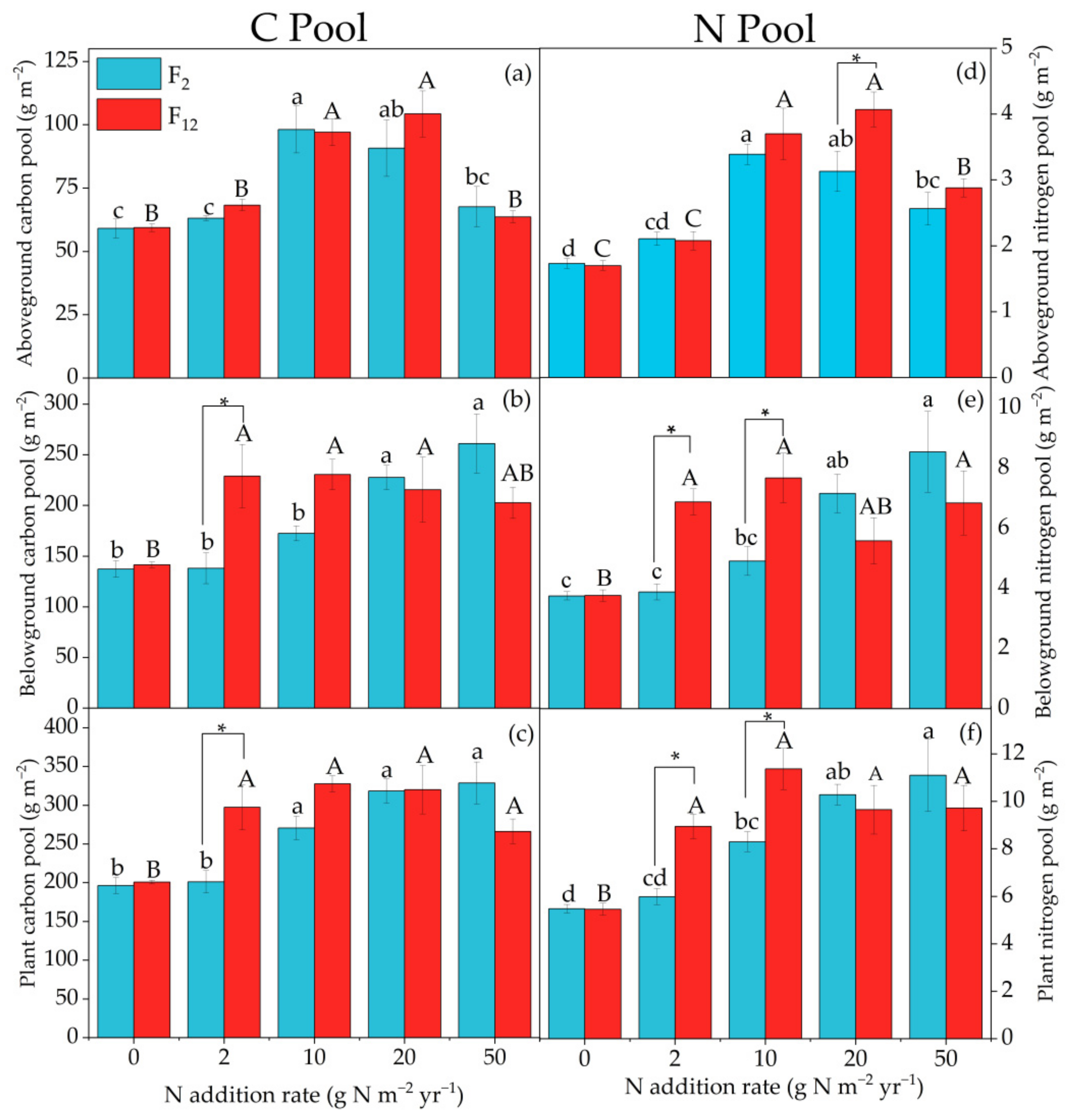
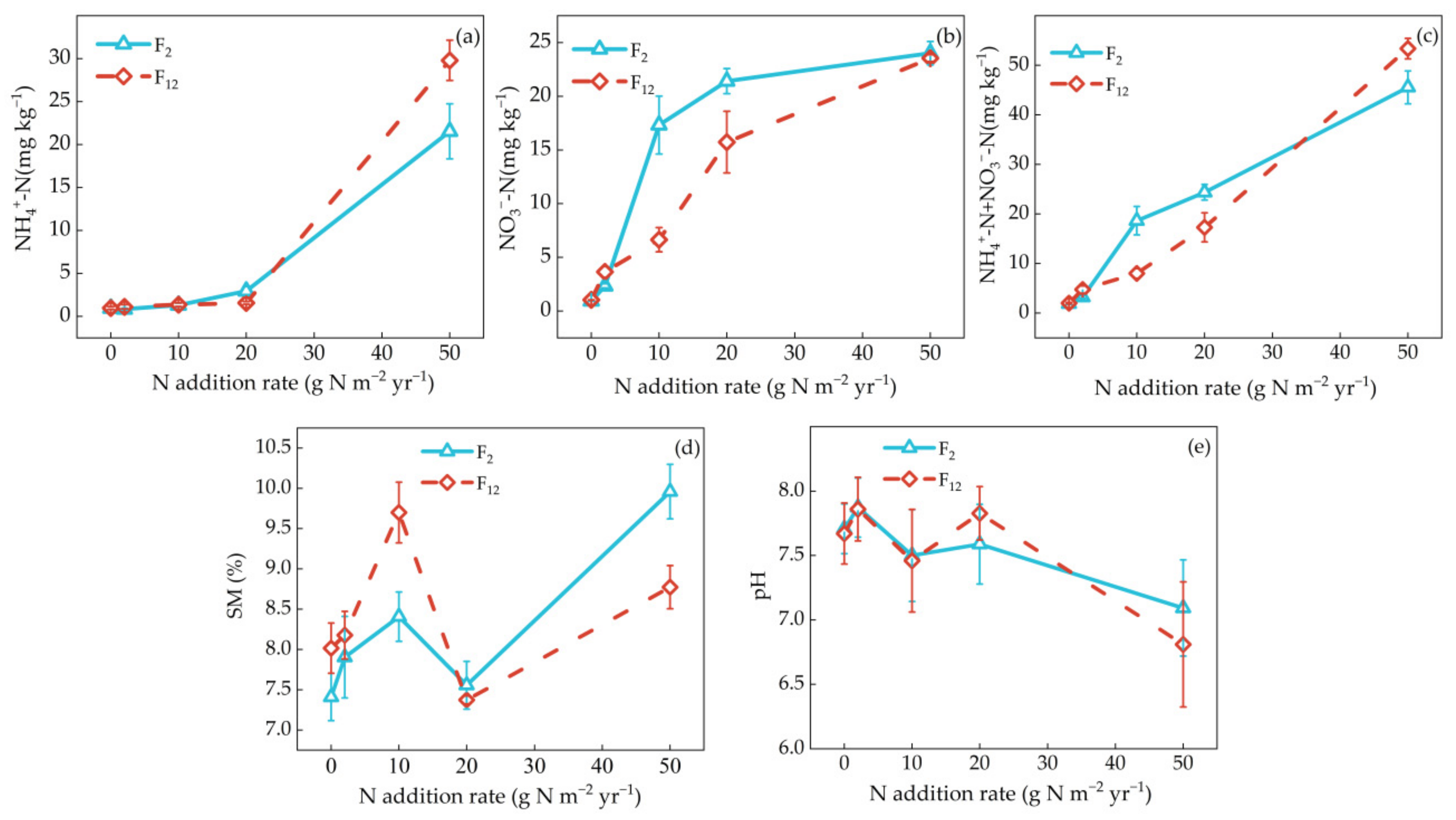
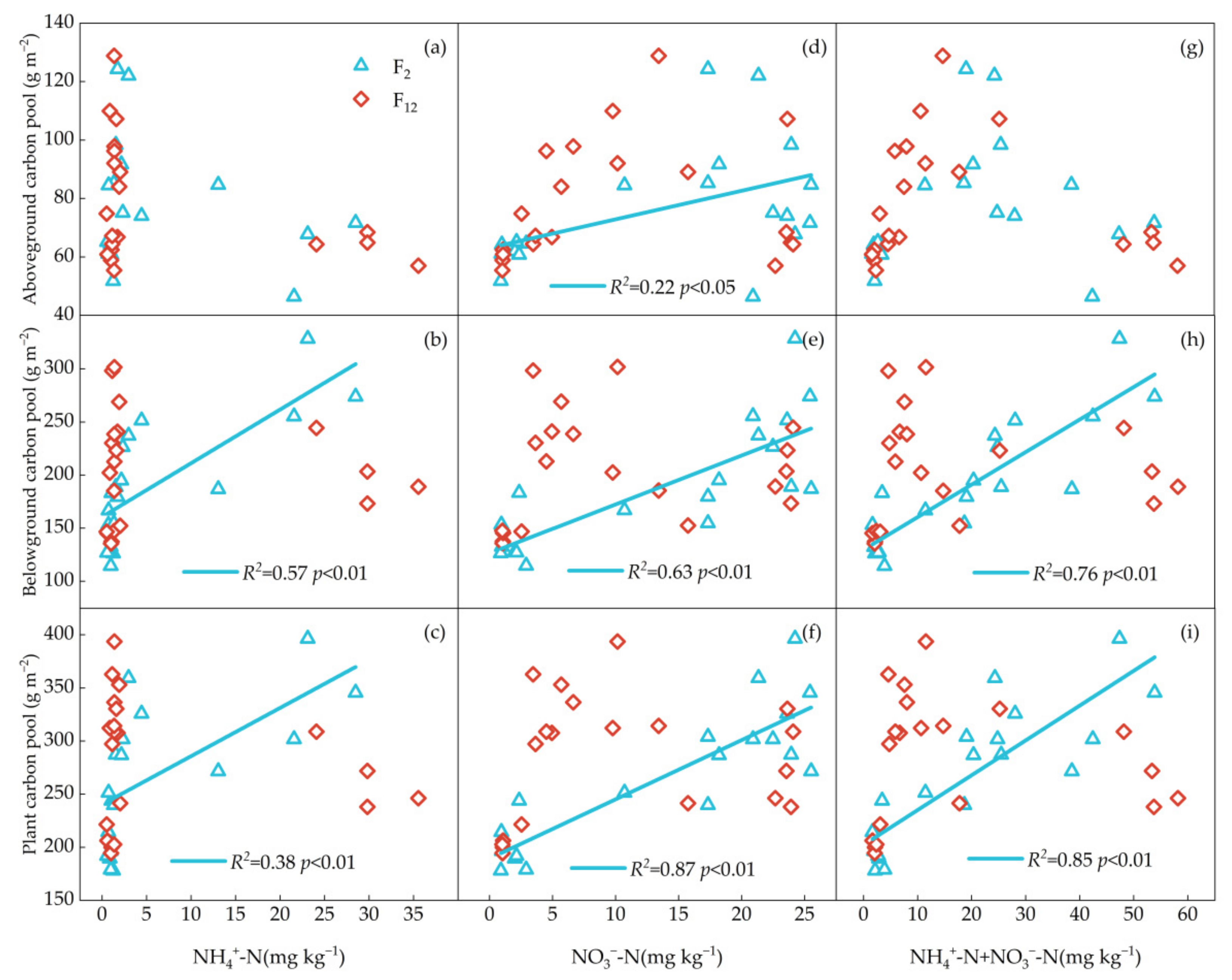
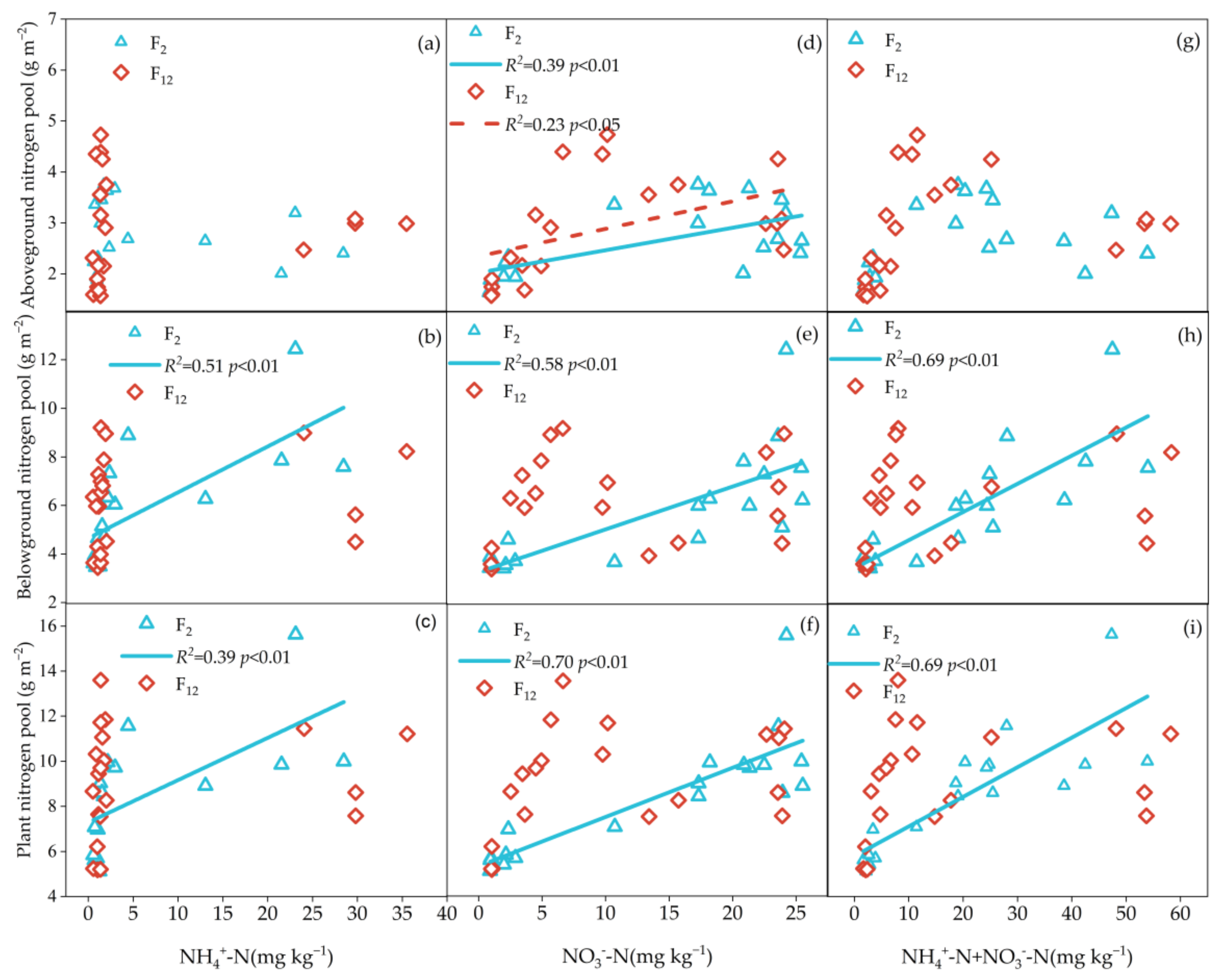
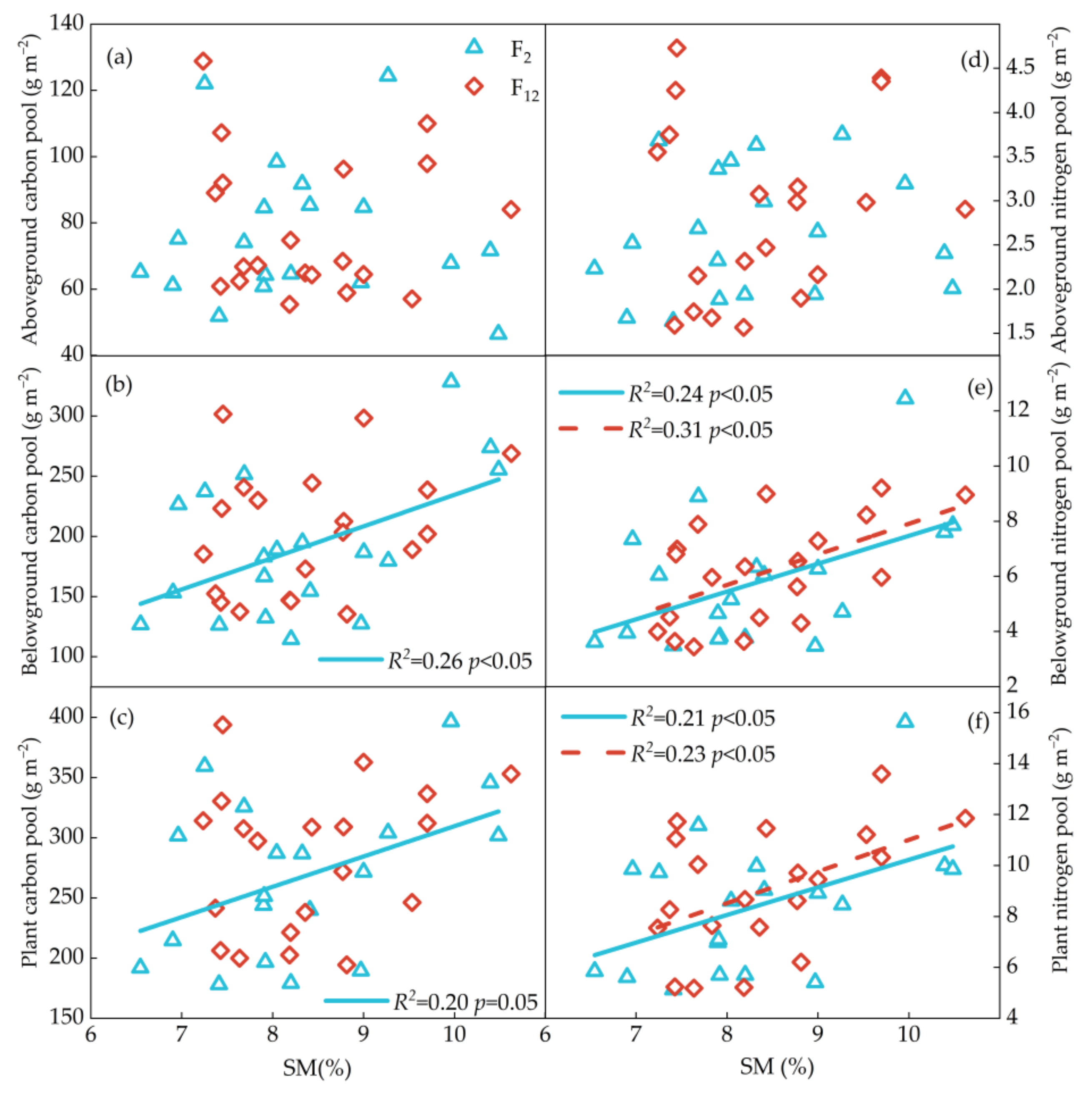

| PAGC | PBGC | PC | PAGN | PBGN | PN | |
|---|---|---|---|---|---|---|
| N | 16.27 *** | 6.21 * | 11.46 *** | 28.57 *** | 7.28 *** | 13.33 *** |
| F | 0.44 | 1.68 | 2.37 | 4.68 * | 1.12 | 2.52 |
| N × F | 0.69 | 4.41 | 4.77 * | 1.62 | 4.84 ** | 3.53 * |
| NH4+-N | NO3−-N | InN | SM | pH | |
|---|---|---|---|---|---|
| N | 139.85 * | 90.10 *** | 182.77 *** | 13.35 *** | 2.46 |
| F | 2.99 | 11.26 *** | 1.74 | 0.69 | 0.01 |
| N × F | 4.44 ** | 6.07 ** | 7.11 *** | 4.11 *** | 0.16 |
Publisher’s Note: MDPI stays neutral with regard to jurisdictional claims in published maps and institutional affiliations. |
© 2022 by the authors. Licensee MDPI, Basel, Switzerland. This article is an open access article distributed under the terms and conditions of the Creative Commons Attribution (CC BY) license (https://creativecommons.org/licenses/by/4.0/).
Share and Cite
Hao, J.; Sun, J.; Dong, K.; Wang, C. Plant C and N Pools Improved by N Addition Levels but Not Frequencies in a Typical Grassland of Northern China. Atmosphere 2022, 13, 851. https://doi.org/10.3390/atmos13060851
Hao J, Sun J, Dong K, Wang C. Plant C and N Pools Improved by N Addition Levels but Not Frequencies in a Typical Grassland of Northern China. Atmosphere. 2022; 13(6):851. https://doi.org/10.3390/atmos13060851
Chicago/Turabian StyleHao, Jie, Jianping Sun, Kuanhu Dong, and Changhui Wang. 2022. "Plant C and N Pools Improved by N Addition Levels but Not Frequencies in a Typical Grassland of Northern China" Atmosphere 13, no. 6: 851. https://doi.org/10.3390/atmos13060851
APA StyleHao, J., Sun, J., Dong, K., & Wang, C. (2022). Plant C and N Pools Improved by N Addition Levels but Not Frequencies in a Typical Grassland of Northern China. Atmosphere, 13(6), 851. https://doi.org/10.3390/atmos13060851







